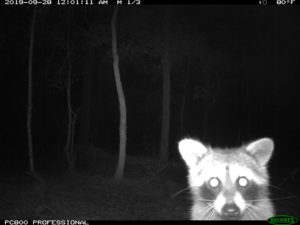
Dr. Christopher Schalk, SFA assistant professor of forest wildlife management, and Dr. Daniel Scognamillo, SFA adjunct professor of forest wildlife management, participated in the first nationwide survey of mammals initiated by the North Carolina Museum of Natural Sciences and the Smithsonian Conservation Biology Institute. The survey, known as Snapshot USA, comprises 1,509 motion-activated camera traps throughout 110 sites in the U.S. Pictured is a common raccoon documented at the Stephen F. Austin Experimental Forest during the survey.
Dr. Christopher Schalk, Stephen F. Austin State University assistant professor of forest wildlife management, and Dr. Daniel Scognamillo, SFA adjunct professor of forest wildlife management, are two of more than 150 researchers from across the continental U.S. to participate in the first nationwide survey of mammals initiated by the North Carolina Museum of Natural Sciences and the Smithsonian Conservation Biology Institute.
The survey, known as Snapshot USA, comprises 1,509 motion-activated camera traps throughout 110 sites in the U.S.
“Our goal was to provide a space for researchers from all 50 states to contribute a subset of their data to a broader initiative to maximize our coverage of the country and better understand drivers of mammal distributions to best inform conservation as rapidly as possible,” said Michael Cove, curator of mammalogy at the North Carolina Museum of Natural Sciences.
Schalk and Scognamillo deployed 19 camera traps throughout the SFA Experimental Forest during September and October 2019 and recorded numerous observations of more than 10 mammal species, including white-tailed deer, Southern flying squirrel, bobcat, coyote and nine-banded armadillo.
“These data are really valuable because they allow researchers to address questions and problems on the ecology and conservation of mammals at broader spatial scales,” Schalk said.
The results of Snapshot USA were featured in Ecology, a peer-reviewed journal published by the Ecological Society of America. The 2019 survey data also is publicly available at emammal.si.edu/snapshot-usa.
Story by Sarah Fuller, outreach coordinator for Stephen F. Austin State University’s Arthur Temple College of Forestry and Agriculture.



